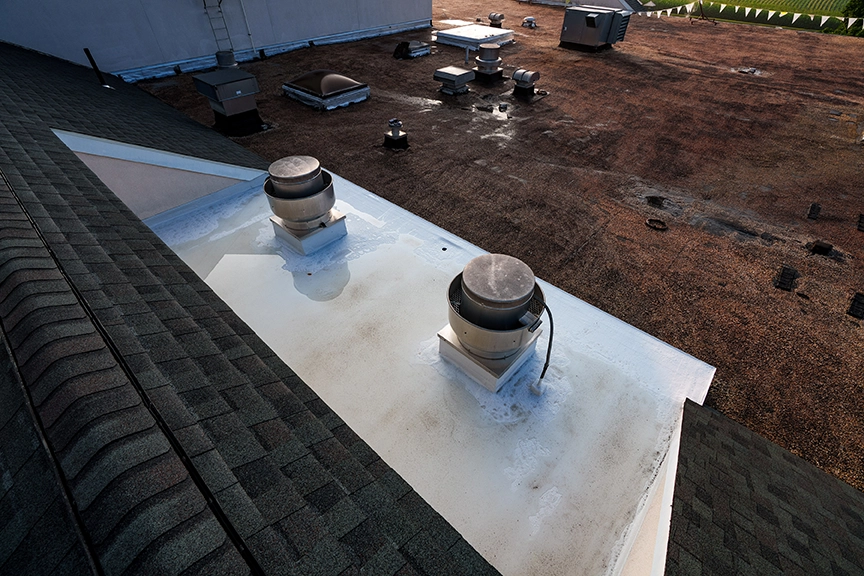How to Select the Right Roofing Material for Your Facility
If you own a commercial or industrial facility, you know that one of the largest and most important surfaces in your complex is the roof. But how do you know if you have the right commercial building roof type to maximize your building’s durability, energy efficiency, and overall cost?

If you are building a facility from scratch, your roofing possibilities are unlimited, but if you are considering a commercial roof restoration, you may face some limitations due to the materials currently in place, such as the underlying roofing structure composition and roof pitch. Furthermore, if you are adding an addition, your roofing material choices need to function and blend in with the existing construction.
No matter what situation you are in, there are several factors that should be considered to make an informed choice about what commercial roof type is right for your facility.
Building Needs
Your industrial facility’s climate and building use should be considered before selecting a roofing material. Consider the local weather conditions, including temperature ranges, precipitation, and the potential for extreme weather events. Depending upon the type of facility you have, for example, a warehouse or manufacturing facility, you may have specific requirements that need to be met to select the right roof. Some examples include insulation, fire resistance, and durability.
Consider Longevity and Durability
Before selecting roofing material, you should assess the expected lifespan of the product. While some materials like metal and thermoplastic polyolefin (TPO) can last several decades, others—like asphalt shingles—may need to be replaced more frequently.
Another thing to consider when exploring roofing options is to determine if the material is resistant to local environmental factors, such as UV radiation, wind, and potential impacts from debris.
Energy Efficiency
If you want your roof to be energy-efficient, you should choose a material with high reflectivity and insulation properties to reduce cooling and heating costs. By applying a reflective coating to an existing roof, facility owners can enhance their building’s solar reflectance. If you are installing a new roof, consider a cool roofing material with inherent reflective properties, such as cool roof shingles or tiles or metal roofing. Both a cool roof and a metal roof coating reflect more sunlight and absorb less heat.
Maintenance Requirements
Every roofing material has different commercial roof maintenance program requirements. Some materials need more frequent inspections and repairs, which can add to long-term costs. You should also evaluate the ease of access for roof maintenance and repairs, especially for large or complex roof structures.
Budget
In addition to the initial installation cost, a commercial roof’s long-term maintenance expenses should also be taken into consideration. These costs should include a routine commercial roof maintenance plan and emergency roof repair costs.
If you have an energy-efficient roof, you may be eligible for potential tax incentives or rebates for energy-efficient roofing materials. Check to see if your roof qualifies by visiting the Department of Energy.
Building Codes and Regulations
Whatever roofing material you choose should be checked to ensure it meets local building codes and regulations. Fire ratings and wind resistance are examples of safety standards that could apply to your region and should be considered. Some municipalities also have building requirements that dictate the types and grades of roofing that must be used.
State building codes may also require a specific type of roofing material. If you live in a state that is at risk for hurricanes, tornadoes, or forest fires, your commercial facility may be prohibited from using certain types of roof shingles.
Evaluate Roofing Materials
Here is a list of the most common types of commercial roofing materials that should be considered:
- Asphalt Shingles: This roofing material is cost-effective, easy to install, and suitable for various climates. However, asphalt shingles may not be as durable as other options.
- Metal: Long-lasting, energy-efficient, and suitable for harsh weather conditions, a metal roof can be more expensive initially, but it often offers better long-term value.
- Ethylene Propylene Diene Monomer (EPDM)/Rubber: Comprised of a synthetic, durable, rubber roofing membrane, EPDM is excellent for flat roofs and has good weather resistance.
- Single-Ply: A single-ply roof is a flexible roof system made of a single-layer waterproof membrane that is typically comprised of a synthetic polymer and can be 1.1–2.0 mm thick.
- Cool: A commercial cool roof system is designed to reflect sunlight and absorb less heat. Cool roofs use bright solar-reflective surfaces to maintain lower temperatures.
- Foam: Also known as spray polyurethane foam (SPF), a foam roof is lightweight, watertight, and energy efficient. This roofing material is sprayed onto an existing roof as a liquid and then expands into a solid foam layer.
- Tar and Gravel: Also known as a built-up roof (BUR) or conventional built-up roof (CBUR), tar and gravel roofs are flat and made up of layers of asphalt, tar, roofing felt, and gravel. The top layer is covered with light-colored gravel that reflects sunlight and protects the layers from sun damage and the elements.
- Thermoplastic Roofing (TPO, PVC): This type of roof is lightweight, reflective, and resistant to chemicals and ultraviolet light. TPO is ideal for flat roofs and areas with high solar exposure.
By carefully evaluating all these factors, you can select the appropriate type of commercial roof for your industrial facility, while balancing cost, performance, and durability. To help aid you in this decision, it’s advisable to consult with a professional roofing contractor, like Capital Roof Care that has experience with commercial facilities and can provide expert recommendations based on your facility’s needs.
Sources: